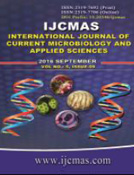


 National Academy of Agricultural Sciences (NAAS)
National Academy of Agricultural Sciences (NAAS)

|
PRINT ISSN : 2319-7692
Online ISSN : 2319-7706 Issues : 12 per year Publisher : Excellent Publishers Email : editorijcmas@gmail.com / submit@ijcmas.com Editor-in-chief: Dr.M.Prakash Index Copernicus ICV 2018: 95.39 NAAS RATING 2020: 5.38 |
The aim of this study was to explore the potential role of Transforming growth factor-beta1 (TGF-β1), tumor necrosis factor-alpha (TNF-alpha) and serum high-sensitivity C-reactive protein (hs-CRP) in the Non-alcoholic fatty liver disease (NAFLD). A total of (30) patients with Non-alcoholic fatty liver disease (NAFLD) were included in this study. All patients received the concentrations of serum TGF-β1,TNF-alpha and hs-CRP were measured, and compared with (20) healthy subject as control group. Serum TGF--β1 concentration in patients with NAFLD (4.33±0.36 ng/ml) was significantly higher than healthy controls (2.83±0.18 ng/ml), [P < 0.05], as well as, TNF-alpha levels in patients were (42.76±2.54pg/ml) which significantly higher [P < 0.05] than the control group (42.76±2.54 pg/ml). Serum hs-CRP levels in patients were (4.51±0.87mg/L) and in control group (2.12±0.19mg/L). The area under ROC curve, hs_CRP ~ TNF-α= 0.0656, hs_CRP ~ TGF-β1= 0.273; TGF-β1 ~ TNF-α= 0.4561). TGF--β1 was the more sensitive than TNF-α and hs-CRP (73.3%, 63.3% and 60.0%, respectively). Serum TGF-β1, TNF-alpha and hs-CRP significantly elevated in patients with NAFLD. TGF-β1 was more sensitive than the other two studied parameters.Serum TGF-β1, TNF-alpha and hs-CRP may be used as a markers for monitor the development of NAFLD and can reflect the severity of liver damage.
 |
 |
 |
 |
 |